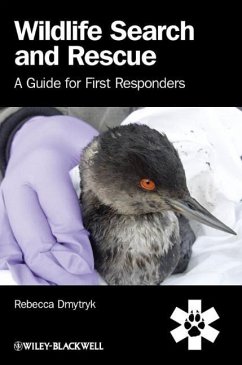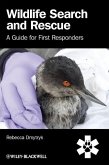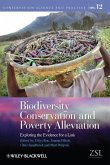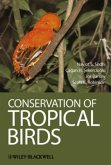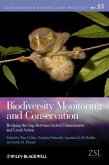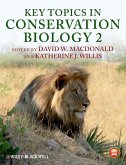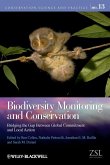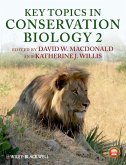Rebecca Dmytryk
Wildlife Search and Rescue
Rebecca Dmytryk
Wildlife Search and Rescue
- Broschiertes Buch
- Merkliste
- Auf die Merkliste
- Bewerten Bewerten
- Teilen
- Produkt teilen
- Produkterinnerung
- Produkterinnerung
Rescuing wild animals in distress requires a unique set of skills, very different from those used in handling domestic animals. The equipment, degree of handling, the type of caging and level of care a wild animal receives can mean the difference between life and death. Wildlife Search and Rescue is a comprehensive guide on 'best practices' and suggested standards for response to sick, injured and orphaned wildlife. This valuable resource covers the fundamentals of wildlife rescue, from 'phone to field', including safe and successful capture strategies, handling and restraint techniques and…mehr
Andere Kunden interessierten sich auch für
![Wildlife Search and Rescue Wildlife Search and Rescue]() Rebecca DmytrykWildlife Search and Rescue194,99 €
Rebecca DmytrykWildlife Search and Rescue194,99 €![Biodiversity Conservation and Poverty Alleviation Biodiversity Conservation and Poverty Alleviation]() Biodiversity Conservation and Poverty Alleviation105,99 €
Biodiversity Conservation and Poverty Alleviation105,99 €![Conservation of Tropical Birds Conservation of Tropical Birds]() Navjot S. SodhiConservation of Tropical Birds145,99 €
Navjot S. SodhiConservation of Tropical Birds145,99 €![Biodiversity Monitoring and Conservation Biodiversity Monitoring and Conservation]() Biodiversity Monitoring and Conservation193,99 €
Biodiversity Monitoring and Conservation193,99 €![Key Topics in Conservation Biology 2 Key Topics in Conservation Biology 2]() Key Topics in Conservation Biology 2115,99 €
Key Topics in Conservation Biology 2115,99 €![Biodiversity Monitoring and Conservation Biodiversity Monitoring and Conservation]() Biodiversity Monitoring and Conservation115,99 €
Biodiversity Monitoring and Conservation115,99 €![Key Topics in Conservation Biology 2 Key Topics in Conservation Biology 2]() Key Topics in Conservation Biology 2182,99 €
Key Topics in Conservation Biology 2182,99 €-
-
-
Rescuing wild animals in distress requires a unique set of skills, very different from those used in handling domestic animals. The equipment, degree of handling, the type of caging and level of care a wild animal receives can mean the difference between life and death. Wildlife Search and Rescue is a comprehensive guide on 'best practices' and suggested standards for response to sick, injured and orphaned wildlife. This valuable resource covers the fundamentals of wildlife rescue, from 'phone to field', including safe and successful capture strategies, handling and restraint techniques and initial aid. Wildlife Search and Rescue is a must have for anyone interested in knowing what to do when they are face to face with a wild animal in need, or for anyone involved in animal rescue. While the book focuses on wildlife native to North America, much of the information and many of the techniques are applicable to other species, including domestic dogs and cats.
Visit www.wiley.com/go/dmytryk/wildlifeemergency to access the figures from the book.
Hinweis: Dieser Artikel kann nur an eine deutsche Lieferadresse ausgeliefert werden.
Visit www.wiley.com/go/dmytryk/wildlifeemergency to access the figures from the book.
Hinweis: Dieser Artikel kann nur an eine deutsche Lieferadresse ausgeliefert werden.
Produktdetails
- Produktdetails
- Verlag: Wiley & Sons
- 1. Auflage
- Seitenzahl: 256
- Erscheinungstermin: 30. Januar 2012
- Englisch
- Abmessung: 241mm x 159mm x 13mm
- Gewicht: 426g
- ISBN-13: 9780470655115
- ISBN-10: 0470655119
- Artikelnr.: 34998924
- Herstellerkennzeichnung
- Libri GmbH
- Europaallee 1
- 36244 Bad Hersfeld
- gpsr@libri.de
- Verlag: Wiley & Sons
- 1. Auflage
- Seitenzahl: 256
- Erscheinungstermin: 30. Januar 2012
- Englisch
- Abmessung: 241mm x 159mm x 13mm
- Gewicht: 426g
- ISBN-13: 9780470655115
- ISBN-10: 0470655119
- Artikelnr.: 34998924
- Herstellerkennzeichnung
- Libri GmbH
- Europaallee 1
- 36244 Bad Hersfeld
- gpsr@libri.de
In the last thirty years, Rebecca Dmytryk has become a leading authority in wildlife rescue having been on the front lines of some of the largest wildlife recovery missions, including the Gulf Oil Spill. From her office in Monterey, California she and her husband, Duane Titus operate WildRescue, offering around the clock response to emergencies involving wildlife and serving all of California with a state-of-the-art toll-free wildlife hotline.
Foreword Jay Holcomb xiii
Preface xvii
1 Overview of wildlife rescue 1
2 Characterizing wildlife search and rescue 3
3 Laws and regulations governing wildlife rescue in the USA 7
4 Code of practice 10
5 The components of wildlife search and rescue 11
Human safety 11
Environmental hazards 11
Human factor hazards 12
Equipment hazards 13
Health risks 13
Zoonotic diseases 15
Bacterial infections 15
Fungal infections 18
Viruses 19
Parasites 19
Personal protective equipment 22
Protection from hazardous materials 24
Basic safety and preparedness guidelines 26
Operational risk management 27
Outfitting 32The welfare of the animal 34
Understanding stress 35
Minimizing stress during rescue operations 38
Potential for success 40
The mindset of the hunter and the hunted 42
The importance of natural history 42
The fundamentals of the search 43
The fundamentals of the capture 45
6 Anatomy of a response team 52
7 Overview of wildlife capture equipment 55
The towel 55
Herding boards 55
Nets and netting 57
The hoop net 57
The open-ended hoop net 58
The throw net 60
Land seine 60
Mechanical nets 60
Active land seine 60
The bow net and Q-net 61
The whoosh net 62
Driving, funnel, and walk-in traps 63
The dho-gaza 66
Drop traps 66
Cage traps 68
Projectile-powered nets 68
Lures 69
Catchpole 70
8 Capture, handling, and confinement of wild birds 71
Techniques for capturing wild birds 71
Enticing wild birds using lures 71
The Bartos trap 76
Snare-type traps 76
Bal-chatri 76
The phai trap 78
Noose carpets 79
The single snare 79
Leg snare pole 84
Swan hook 85
Pit traps 85
Mist nets 86
On the water 86
Floating gill nets 88
Floating barriers and submersible pens 89
Spotlighting 90
Special circumstances and particular methods 92
Hummingbirds 92
Loons (Gaviiformes) 93
Grebes (Podicipediformes) 94
Rails and coots (Rallidae) 94
Brown pelican (Pelecanus occidentalis) 95
Cormorants (Phalacrocoracidae) 97
Waders 97
Alcids 98
Birds trapped in structures 98
Hummingbirds in skylights 99
Window strikes 100
Ducklings in a pool 100
Birds entangled in fishing tackle 104
Rodenticide poisoning 105
Shot through with a projectile 105
Glue traps 109
Avian botulism 110
Lead poisoning 111
Domoic acid poisoning (DAP) 111
''Sea slime'' 113
Oil and petroleum products 113
Handling and restraint of wild birds 117
Processing from nets and housing 124
Short-term and temporary housing for wild birds 124
9 Capture, handling, and confinement of land mammals 130
Techniques for capturing wild mammals 130
Chemical immobilization 131
Special circumstances and particular methods 131
Small rodents 131
Large rodents, porcupines, beaver 132
Lagomorphs, rabbits and hares 132
Xenarthrans, anteaters, armadillos 132
Skunks 133
Canids 133
Deer 133
Physical restraint of land mammals 134
Bats 134
Small rodents 135
Talpids, moles and relatives 136
Squirrels 137
Opossums 137
Porcupines 137
Lagomorphs, rabbits and hares 138
Small and medium-sized carnvores 138
Mustelids, badger, otter, weasels 139
Skunks 139
Coyotes and foxes 139
Felids 140
Processing mammals from nets and cages 140
Temporary confinement of land mammals 142
10 Capture and handling of reptiles and amphibians 145
11 Marine mammal rescue 146
Rescuing seals and sea lions 146
Young seals and sea lions 147
Hoop nets 149
Modified open-ended hoop net 149
Wraps, slings, and stretchers 151
The towel wrap 151
Flat webbing cargo net 152
The floating net 153
Physical restraint of seals and sea lions 153
Confinement and transport of pinnipeds 153
Cetaceans 156
12 Basic wildlife first aid and stabilization 158
Performing a cursory physical examination 159
Bleeding 161
Dehydration 161
Fluid therapy 162
Oral fluid administration (mammals) 164
Oral fluid administration (birds) 165
Subcutaneous injections 168
Treating hypothermia 170
Treating Hyperthermia 171
Basic wound care 172
Stabilizing fractures 173
Robert Jones bandage 174
Figure-eight wrap 174
Bird body wrap 176
The ball bandage 176
13 Transporting wildlife 177
14 Field euthanasia 179
15 Life, liberty, and euthanasia 182
16 Rescuing baby birds and land mammals 184
17 Reuniting, re-nesting, and wild-fostering 185
Returning altricial chicks to the wild 187
Returning precocial chicks to the wild 193
Returning baby mammals to the wild 195
Nutritional support 198
18 Offering public service 200
Public relations and the art of shapeshifting 202
Contracting with municipalities 203
Appendix 1 Ready packs 204
Appendix 2 Wildlife observation form 206
Appendix 3 Wildlife trauma equipment and supplies 207
Appendix 4 Instructions for tying nooses 209
Appendix 5 Barn owl box plans and instructions 211
Appendix 6 Sample contract 213
Further reading 220
Index 222
Preface xvii
1 Overview of wildlife rescue 1
2 Characterizing wildlife search and rescue 3
3 Laws and regulations governing wildlife rescue in the USA 7
4 Code of practice 10
5 The components of wildlife search and rescue 11
Human safety 11
Environmental hazards 11
Human factor hazards 12
Equipment hazards 13
Health risks 13
Zoonotic diseases 15
Bacterial infections 15
Fungal infections 18
Viruses 19
Parasites 19
Personal protective equipment 22
Protection from hazardous materials 24
Basic safety and preparedness guidelines 26
Operational risk management 27
Outfitting 32The welfare of the animal 34
Understanding stress 35
Minimizing stress during rescue operations 38
Potential for success 40
The mindset of the hunter and the hunted 42
The importance of natural history 42
The fundamentals of the search 43
The fundamentals of the capture 45
6 Anatomy of a response team 52
7 Overview of wildlife capture equipment 55
The towel 55
Herding boards 55
Nets and netting 57
The hoop net 57
The open-ended hoop net 58
The throw net 60
Land seine 60
Mechanical nets 60
Active land seine 60
The bow net and Q-net 61
The whoosh net 62
Driving, funnel, and walk-in traps 63
The dho-gaza 66
Drop traps 66
Cage traps 68
Projectile-powered nets 68
Lures 69
Catchpole 70
8 Capture, handling, and confinement of wild birds 71
Techniques for capturing wild birds 71
Enticing wild birds using lures 71
The Bartos trap 76
Snare-type traps 76
Bal-chatri 76
The phai trap 78
Noose carpets 79
The single snare 79
Leg snare pole 84
Swan hook 85
Pit traps 85
Mist nets 86
On the water 86
Floating gill nets 88
Floating barriers and submersible pens 89
Spotlighting 90
Special circumstances and particular methods 92
Hummingbirds 92
Loons (Gaviiformes) 93
Grebes (Podicipediformes) 94
Rails and coots (Rallidae) 94
Brown pelican (Pelecanus occidentalis) 95
Cormorants (Phalacrocoracidae) 97
Waders 97
Alcids 98
Birds trapped in structures 98
Hummingbirds in skylights 99
Window strikes 100
Ducklings in a pool 100
Birds entangled in fishing tackle 104
Rodenticide poisoning 105
Shot through with a projectile 105
Glue traps 109
Avian botulism 110
Lead poisoning 111
Domoic acid poisoning (DAP) 111
''Sea slime'' 113
Oil and petroleum products 113
Handling and restraint of wild birds 117
Processing from nets and housing 124
Short-term and temporary housing for wild birds 124
9 Capture, handling, and confinement of land mammals 130
Techniques for capturing wild mammals 130
Chemical immobilization 131
Special circumstances and particular methods 131
Small rodents 131
Large rodents, porcupines, beaver 132
Lagomorphs, rabbits and hares 132
Xenarthrans, anteaters, armadillos 132
Skunks 133
Canids 133
Deer 133
Physical restraint of land mammals 134
Bats 134
Small rodents 135
Talpids, moles and relatives 136
Squirrels 137
Opossums 137
Porcupines 137
Lagomorphs, rabbits and hares 138
Small and medium-sized carnvores 138
Mustelids, badger, otter, weasels 139
Skunks 139
Coyotes and foxes 139
Felids 140
Processing mammals from nets and cages 140
Temporary confinement of land mammals 142
10 Capture and handling of reptiles and amphibians 145
11 Marine mammal rescue 146
Rescuing seals and sea lions 146
Young seals and sea lions 147
Hoop nets 149
Modified open-ended hoop net 149
Wraps, slings, and stretchers 151
The towel wrap 151
Flat webbing cargo net 152
The floating net 153
Physical restraint of seals and sea lions 153
Confinement and transport of pinnipeds 153
Cetaceans 156
12 Basic wildlife first aid and stabilization 158
Performing a cursory physical examination 159
Bleeding 161
Dehydration 161
Fluid therapy 162
Oral fluid administration (mammals) 164
Oral fluid administration (birds) 165
Subcutaneous injections 168
Treating hypothermia 170
Treating Hyperthermia 171
Basic wound care 172
Stabilizing fractures 173
Robert Jones bandage 174
Figure-eight wrap 174
Bird body wrap 176
The ball bandage 176
13 Transporting wildlife 177
14 Field euthanasia 179
15 Life, liberty, and euthanasia 182
16 Rescuing baby birds and land mammals 184
17 Reuniting, re-nesting, and wild-fostering 185
Returning altricial chicks to the wild 187
Returning precocial chicks to the wild 193
Returning baby mammals to the wild 195
Nutritional support 198
18 Offering public service 200
Public relations and the art of shapeshifting 202
Contracting with municipalities 203
Appendix 1 Ready packs 204
Appendix 2 Wildlife observation form 206
Appendix 3 Wildlife trauma equipment and supplies 207
Appendix 4 Instructions for tying nooses 209
Appendix 5 Barn owl box plans and instructions 211
Appendix 6 Sample contract 213
Further reading 220
Index 222
Foreword Jay Holcomb xiii
Preface xvii
1 Overview of wildlife rescue 1
2 Characterizing wildlife search and rescue 3
3 Laws and regulations governing wildlife rescue in the USA 7
4 Code of practice 10
5 The components of wildlife search and rescue 11
Human safety 11
Environmental hazards 11
Human factor hazards 12
Equipment hazards 13
Health risks 13
Zoonotic diseases 15
Bacterial infections 15
Fungal infections 18
Viruses 19
Parasites 19
Personal protective equipment 22
Protection from hazardous materials 24
Basic safety and preparedness guidelines 26
Operational risk management 27
Outfitting 32The welfare of the animal 34
Understanding stress 35
Minimizing stress during rescue operations 38
Potential for success 40
The mindset of the hunter and the hunted 42
The importance of natural history 42
The fundamentals of the search 43
The fundamentals of the capture 45
6 Anatomy of a response team 52
7 Overview of wildlife capture equipment 55
The towel 55
Herding boards 55
Nets and netting 57
The hoop net 57
The open-ended hoop net 58
The throw net 60
Land seine 60
Mechanical nets 60
Active land seine 60
The bow net and Q-net 61
The whoosh net 62
Driving, funnel, and walk-in traps 63
The dho-gaza 66
Drop traps 66
Cage traps 68
Projectile-powered nets 68
Lures 69
Catchpole 70
8 Capture, handling, and confinement of wild birds 71
Techniques for capturing wild birds 71
Enticing wild birds using lures 71
The Bartos trap 76
Snare-type traps 76
Bal-chatri 76
The phai trap 78
Noose carpets 79
The single snare 79
Leg snare pole 84
Swan hook 85
Pit traps 85
Mist nets 86
On the water 86
Floating gill nets 88
Floating barriers and submersible pens 89
Spotlighting 90
Special circumstances and particular methods 92
Hummingbirds 92
Loons (Gaviiformes) 93
Grebes (Podicipediformes) 94
Rails and coots (Rallidae) 94
Brown pelican (Pelecanus occidentalis) 95
Cormorants (Phalacrocoracidae) 97
Waders 97
Alcids 98
Birds trapped in structures 98
Hummingbirds in skylights 99
Window strikes 100
Ducklings in a pool 100
Birds entangled in fishing tackle 104
Rodenticide poisoning 105
Shot through with a projectile 105
Glue traps 109
Avian botulism 110
Lead poisoning 111
Domoic acid poisoning (DAP) 111
''Sea slime'' 113
Oil and petroleum products 113
Handling and restraint of wild birds 117
Processing from nets and housing 124
Short-term and temporary housing for wild birds 124
9 Capture, handling, and confinement of land mammals 130
Techniques for capturing wild mammals 130
Chemical immobilization 131
Special circumstances and particular methods 131
Small rodents 131
Large rodents, porcupines, beaver 132
Lagomorphs, rabbits and hares 132
Xenarthrans, anteaters, armadillos 132
Skunks 133
Canids 133
Deer 133
Physical restraint of land mammals 134
Bats 134
Small rodents 135
Talpids, moles and relatives 136
Squirrels 137
Opossums 137
Porcupines 137
Lagomorphs, rabbits and hares 138
Small and medium-sized carnvores 138
Mustelids, badger, otter, weasels 139
Skunks 139
Coyotes and foxes 139
Felids 140
Processing mammals from nets and cages 140
Temporary confinement of land mammals 142
10 Capture and handling of reptiles and amphibians 145
11 Marine mammal rescue 146
Rescuing seals and sea lions 146
Young seals and sea lions 147
Hoop nets 149
Modified open-ended hoop net 149
Wraps, slings, and stretchers 151
The towel wrap 151
Flat webbing cargo net 152
The floating net 153
Physical restraint of seals and sea lions 153
Confinement and transport of pinnipeds 153
Cetaceans 156
12 Basic wildlife first aid and stabilization 158
Performing a cursory physical examination 159
Bleeding 161
Dehydration 161
Fluid therapy 162
Oral fluid administration (mammals) 164
Oral fluid administration (birds) 165
Subcutaneous injections 168
Treating hypothermia 170
Treating Hyperthermia 171
Basic wound care 172
Stabilizing fractures 173
Robert Jones bandage 174
Figure-eight wrap 174
Bird body wrap 176
The ball bandage 176
13 Transporting wildlife 177
14 Field euthanasia 179
15 Life, liberty, and euthanasia 182
16 Rescuing baby birds and land mammals 184
17 Reuniting, re-nesting, and wild-fostering 185
Returning altricial chicks to the wild 187
Returning precocial chicks to the wild 193
Returning baby mammals to the wild 195
Nutritional support 198
18 Offering public service 200
Public relations and the art of shapeshifting 202
Contracting with municipalities 203
Appendix 1 Ready packs 204
Appendix 2 Wildlife observation form 206
Appendix 3 Wildlife trauma equipment and supplies 207
Appendix 4 Instructions for tying nooses 209
Appendix 5 Barn owl box plans and instructions 211
Appendix 6 Sample contract 213
Further reading 220
Index 222
Preface xvii
1 Overview of wildlife rescue 1
2 Characterizing wildlife search and rescue 3
3 Laws and regulations governing wildlife rescue in the USA 7
4 Code of practice 10
5 The components of wildlife search and rescue 11
Human safety 11
Environmental hazards 11
Human factor hazards 12
Equipment hazards 13
Health risks 13
Zoonotic diseases 15
Bacterial infections 15
Fungal infections 18
Viruses 19
Parasites 19
Personal protective equipment 22
Protection from hazardous materials 24
Basic safety and preparedness guidelines 26
Operational risk management 27
Outfitting 32The welfare of the animal 34
Understanding stress 35
Minimizing stress during rescue operations 38
Potential for success 40
The mindset of the hunter and the hunted 42
The importance of natural history 42
The fundamentals of the search 43
The fundamentals of the capture 45
6 Anatomy of a response team 52
7 Overview of wildlife capture equipment 55
The towel 55
Herding boards 55
Nets and netting 57
The hoop net 57
The open-ended hoop net 58
The throw net 60
Land seine 60
Mechanical nets 60
Active land seine 60
The bow net and Q-net 61
The whoosh net 62
Driving, funnel, and walk-in traps 63
The dho-gaza 66
Drop traps 66
Cage traps 68
Projectile-powered nets 68
Lures 69
Catchpole 70
8 Capture, handling, and confinement of wild birds 71
Techniques for capturing wild birds 71
Enticing wild birds using lures 71
The Bartos trap 76
Snare-type traps 76
Bal-chatri 76
The phai trap 78
Noose carpets 79
The single snare 79
Leg snare pole 84
Swan hook 85
Pit traps 85
Mist nets 86
On the water 86
Floating gill nets 88
Floating barriers and submersible pens 89
Spotlighting 90
Special circumstances and particular methods 92
Hummingbirds 92
Loons (Gaviiformes) 93
Grebes (Podicipediformes) 94
Rails and coots (Rallidae) 94
Brown pelican (Pelecanus occidentalis) 95
Cormorants (Phalacrocoracidae) 97
Waders 97
Alcids 98
Birds trapped in structures 98
Hummingbirds in skylights 99
Window strikes 100
Ducklings in a pool 100
Birds entangled in fishing tackle 104
Rodenticide poisoning 105
Shot through with a projectile 105
Glue traps 109
Avian botulism 110
Lead poisoning 111
Domoic acid poisoning (DAP) 111
''Sea slime'' 113
Oil and petroleum products 113
Handling and restraint of wild birds 117
Processing from nets and housing 124
Short-term and temporary housing for wild birds 124
9 Capture, handling, and confinement of land mammals 130
Techniques for capturing wild mammals 130
Chemical immobilization 131
Special circumstances and particular methods 131
Small rodents 131
Large rodents, porcupines, beaver 132
Lagomorphs, rabbits and hares 132
Xenarthrans, anteaters, armadillos 132
Skunks 133
Canids 133
Deer 133
Physical restraint of land mammals 134
Bats 134
Small rodents 135
Talpids, moles and relatives 136
Squirrels 137
Opossums 137
Porcupines 137
Lagomorphs, rabbits and hares 138
Small and medium-sized carnvores 138
Mustelids, badger, otter, weasels 139
Skunks 139
Coyotes and foxes 139
Felids 140
Processing mammals from nets and cages 140
Temporary confinement of land mammals 142
10 Capture and handling of reptiles and amphibians 145
11 Marine mammal rescue 146
Rescuing seals and sea lions 146
Young seals and sea lions 147
Hoop nets 149
Modified open-ended hoop net 149
Wraps, slings, and stretchers 151
The towel wrap 151
Flat webbing cargo net 152
The floating net 153
Physical restraint of seals and sea lions 153
Confinement and transport of pinnipeds 153
Cetaceans 156
12 Basic wildlife first aid and stabilization 158
Performing a cursory physical examination 159
Bleeding 161
Dehydration 161
Fluid therapy 162
Oral fluid administration (mammals) 164
Oral fluid administration (birds) 165
Subcutaneous injections 168
Treating hypothermia 170
Treating Hyperthermia 171
Basic wound care 172
Stabilizing fractures 173
Robert Jones bandage 174
Figure-eight wrap 174
Bird body wrap 176
The ball bandage 176
13 Transporting wildlife 177
14 Field euthanasia 179
15 Life, liberty, and euthanasia 182
16 Rescuing baby birds and land mammals 184
17 Reuniting, re-nesting, and wild-fostering 185
Returning altricial chicks to the wild 187
Returning precocial chicks to the wild 193
Returning baby mammals to the wild 195
Nutritional support 198
18 Offering public service 200
Public relations and the art of shapeshifting 202
Contracting with municipalities 203
Appendix 1 Ready packs 204
Appendix 2 Wildlife observation form 206
Appendix 3 Wildlife trauma equipment and supplies 207
Appendix 4 Instructions for tying nooses 209
Appendix 5 Barn owl box plans and instructions 211
Appendix 6 Sample contract 213
Further reading 220
Index 222

